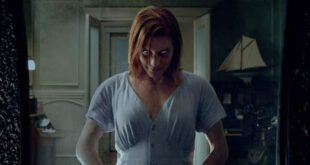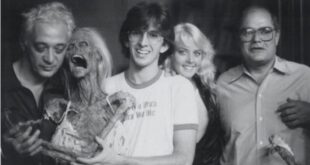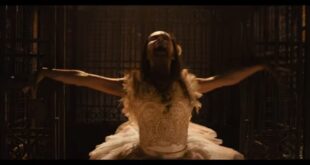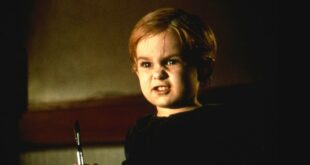In many ways, Wes Craven’s The People Under the Stairs is his most overtly political film, but in no way does that subtract from it. Sure, you can find social critiques in A Nightmare on Elm Street or even minutely in Scream, but political madness is less hidden in this classic released on November 1, 1991. In a quite literal way, this story makes us wonder why some people live in mansions while others in ratty apartments. To those with elitist/supremacist/social Darwinist views, it’s a bit like asking why locks have keys. However, this film challenges those assumptions in a hardcore way.
So much of The People Under the Stairs story hinges on the demented worldviews of the Robeson family—that is, Mommy (Wendy Robie) and Daddy (Everett McGill) Robeson. In fact, the entire neighborhood seems to be impacted by the couple as they buy up more and more properties and price the poor out of their apartments (and presumably, in some cases, homes). When 13-year-old Fool (Brandon Adams) is brought along to help steal money and/or other valuables from the wealthy couple, they all discover just how twisted their household truly is. By the film’s end, there is absolutely no question who the bigger criminals are!
The People Under the Stairs Flips the Script
Wes Craven makes The People Under the Stairs entertaining through its entire runtime and never talks down to you, urging you to fix the problems of the world. After a while, he doesn’t really need to do that anyway. You might find yourself wanting the Robesons dead, their throats slit, and you no longer care that a robbery attempt brought Fool into their madhouse.
The Performance of Ving Rhames

I wouldn’t feel right reviewing this without saying giving some mention to Ving Rhames. Rhames gives a first-rate performance without overshadowing the main character, which is an important, possibly underrated acting skill. the actor has many fine performances and, like some of the best true artists (such as Jimi Hendrix), seems to be modest about his talents. In fact, he famously handed his Golden Globe award to Jack Lemmon in 1998, which Lemmon called “one of the nicest, sweetest moments I’ve ever known in my life.” Although Spike Lee savagely parodied the moment in his 2000 film Bamboozled, it nevertheless seems like a genuine act rather than merely some stunt.
In The People Under the Stairs, Rhames plays the character of Leroy skillfully, giving the performance exactly what it needs while recognizing Fool is intended as the main character. At no point does he overshadow Brandon Adams who, despite being skilled himself, would surely have had a tougher time sharing the spotlight with overdramatic fellow cast members. It’s a role that’s toughed to be charged with, but Rhames handled the nuances with aplomb like a true professional.
What Are The Hidden Terrors In Your Neighborhood?
There actually aren’t that many on-screen murders in The People Under the Stairs, but the ones we get are certainly brutal enough, and we get more than a brief glimpse into the Robeson’s sick world. However, just as memorable are the many unnamed terrors the couple must have inflicted over the years if one stops to think of it. This family has created many hidden horror throughout their reign, and it’s interesting to see all their schemes unravel thanks to one plucky, sassy kid.
It’s also nice to see a Texas Chain Saw Massacre-level mania around a city/suburban environment rather than a small rural setting menaced by twisted rednecks. In fact, these are the sort of maniacs who could attend a city meeting and presumably hail a cab if they couldn’t trust a personal chauffeur. The exterior of their mansion is also somewhat unassuming rather than a spooky house that commands, “You go back that way if you know what’s good for you!”
Final Thoughts
The messaging in The People Under the Stairs is pretty straightforward. It’s not that Fool is too frustrated to stay home after his successful escape, nor is he completely, 100% unafraid to return. He goes back in the Robeson’s direction to seek vengeance. In a story that could have gone in so many different directions, Wes Craven knew it would be cathartic to have Fool rescue Alice (A. J. Langer) and the other kidnapped people. In the process, Fool gets to mete out justice to these rich-ass miscreants who were thieves and social deviants of the highest order but could hide it all behind their wealth!
Again: It’s important to emphasize that the message isn’t that Fool runs from no one, nor does the film suggest he never crossed a line by breaking and entering. Simply, it reminds us that plenty of crimes are committed by rich folks, but they can easily pay others to look the other way, and forms of social bribery. In one scene, Mommy Robeson’s giving the cops cookies perfectly symbolizes this reality.
Although Roger Ebert gave it a thumbs down in The Chicago Sun-Times, it wasn’t an enthusiastic or aggressive thumbs down. I think that’s partly because Ebert (whose opinions I often wouldn’t agree with) recognized the amount of intelligence that went into the story. This isn’t to say it’s the deepest movie ever made, but the depth is there if you want it. Also, who doesn’t love Roach (Sean Whalen) or the warm voice of Kelly Jo Minter?
What are your thoughts on The People Under the Stairs? Let us know in the comments!
 PopHorror Let's Get Scared
PopHorror Let's Get Scared



